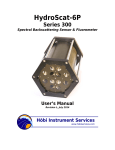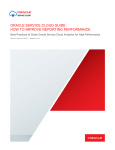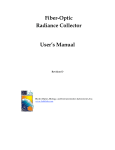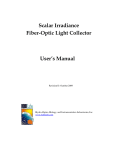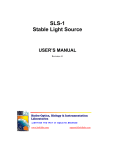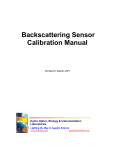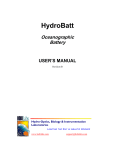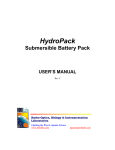Download (Cosine) Collector manual - Hobi Instrument Services
Transcript
Underwater Fiber-Optic Plane Irradiance Collector User’s Manual Revision E, July 2015 Hōbi Instrument Services www.hobiservices.com Revisions E—July, 2015: New formatting and illustrations, notes about immersion correction. D—May 1, 2008: Correct o-ring label on drawing C—June 16, 2004: Change o-ring from 5-102 to 3mm x 1mm B—June 16, 2004: Add explanation of air-optimized version, discussion of cable waterproofing. A—June 13, 2003: First release ii Description The Hobi fiber-optic plane irradiance collector attaches to an SMAterminated fiber optic cable to provide a cosine-weighted angular response to light under water (it is also available in a version optimized for use in air, but with the same waterproof construction). When properly assembled, the 4 Mounting holes for #4 socket cap screws on 0.687" centers collector protects the sensitive end of the fiber optic from water. Note that the fiber FRONT optic cable itself, supplied by the user, must also be constructed so as to prevent water 1/4-36 Thread for SMA from entering its own outer jacket. See below for an explanation of this. SIDE For the most robust water seals, Gland for Parker 2-014 O-ring (optional) such as those used in the underwater cables built into HOBI Labs instruments, BACK the collector includes mounting holes and an o-ring gland for a face seal. These can Gland for 3 mm x 1 mm o-ring (o-ring fits around SMA ferrule) be used to incorporate it into a larger structure to seal and reinforce the entire fiber optic cable. However those features are unnecessary for many stand-alone applications of the collector. Supplied Parts • • • Collector 2-014 o-ring and spare (needed only if mounting to a special fixture) 3mm x 1mm o-ring and spares Using the Collector To provide a water seal, place a 3mm-internal diameter, 1mm wide o-ring around the end of the cable’s SMA ferrule, as shown in the photograph below, before screwing it into place. For best results, tighten the connection by holding the end of the cable stationary rotating the collector. This help to work the o-ring into its groove without pinching it. The connector should be hand-tightened (rather than using a wrench) to avoid stripping the plastic threads. Note that when you remove the SMA, the o-ring will generally remain on the ferrule, and it is easy to overlook the fact that it is there! 3 Inserting SMA connector with o-ring in place If the collector is to be mounted onto a sealing surface, first place a lubricated Parker size 2-012 O-ring in the larger groove around the SMA thread, pass the end of the fiber optic patch cord through the sealing surface, and then attach the cord to the collector. Use #4 screws (not supplied) to attach the collector to the sealing surface. Precautions and Maintenance • • • • • Keep the inside of the collector clean and dry. Cover the SMA fitting with tape or a vinyl cap whenever the fiber optic cable is detached. Do not use a wrench to tighten the connector so much that it could damage the plastic threads. Do not use acetone to clean any part of the collector. Upon removing the collector from salt water, before removing fiber-optic cables, rinse thoroughly with fresh water. Effect of Immersion on Calibration When the light collector is immersed, the change in index of refraction from air to water decreases its transmission efficiency. If you have calibrated your system in air to indicate spectral irradiance, the immersion effect will cause the reported irradiance to be too low. You must multiply the indicated irradiance by a correction factor, which depends on wavelength. As shown in the following plot, the correction factor varies from 1.54 at 300 nm to 1.33 at 880 nm. 4 HR050145_Calibration_Report 9/9/2005 1 Immersion Correction Factor Planar E Immersion Factor 1.60 1.55 1.50 1.45 1.40 1.35 1.30 400 500 600 700 800 Wavelength (nm) Fiber Optic Cable Construction and Waterproofing Most off-the-shelf cables are constructed with a waterproof outer jacket, but this alone does not guarantee the assembly is watertight. The SMA connector on the end of the cable must also be properly sealed at the time of manufacture. Most high-quality cables are sealed in this way. Further, water entry into a cable will not necessarily cause problems. Nevertheless it is best avoided, and users should be aware of the following considerations. The most likely entry point for water is where the cable’s outer jacket enters the fiber optic connector. This is normally covered by a strain-relief “boot” as shown below. This boot may or may not form a seal by itself. SMA termination with boot SMA termination with boot removed The lower picture shows the blue jacket entering the metal part of the connector. At some point inside the connector the jacket ends, at which point it must be sealed. In high-quality commercial cables the connector is typically filled with epoxy, encapsulating the jacket and providing an adequate seal. However since the seal is internal the only way to be sure is to consult the manufacturer. 5 If in doubt, you can provide extra protection by sealing the ends of the boot, or even encapsulating it entirely, with a waterproof adhesive such as the silicone caulking that is used for sealing aquarium tanks. 6









